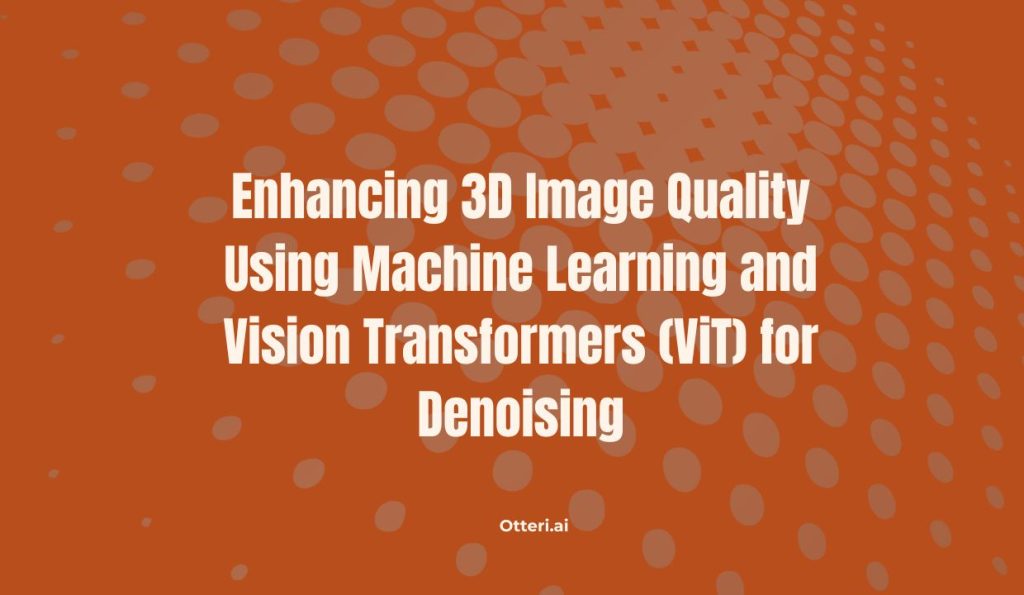
Discover how machine learning and Vision Transformers (ViT) revolutionize 3D denoising. Explore techniques, benefits, and real-world applications for cleaner, sharper 3D imagery.
The Need for 3D Denoising
In the world of computer vision, 3D imaging is critical across fields such as medical diagnostics, autonomous vehicles, and augmented reality. However, raw 3D data is often plagued by noise caused by sensors, environmental interference, or reconstruction errors. This is where 3D denoising becomes essential.
Traditionally, denoising required handcrafted filters, but now machine learning—especially deep learning—offers powerful, data-driven solutions. Among the most promising techniques is the use of Vision Transformers (ViT) for 3D data processing.
Understanding 3D Denoising
3D denoising refers to the process of removing unwanted noise from 3D volumetric or mesh data. Noise not only distorts the visual quality but also reduces the accuracy of downstream tasks like segmentation, classification, and object detection.
Why Machine Learning for 3D Denoising?
Machine learning algorithms can learn complex patterns in noisy data and recover the original clean signal. Unlike traditional filters, ML models adapt based on training data, making them more robust and effective.
Key Benefits:
Adaptive learning from noisy datasets
High preservation of structural details
End-to-end training pipelines
Vision Transformer (ViT): A New Era in 3D Vision
Originally designed for 2D images, ViT treats image patches as sequences, applying the attention mechanism to learn spatial relationships. When extended to 3D, ViTs can analyze voxel grids or point clouds with attention-based mechanisms, enabling advanced 3D denoising capabilities.
ViT in 3D Denoising Offers:
Long-range dependency modeling across 3D space
Enhanced accuracy in identifying noise vs. structure
Scalability for large 3D datasets
How It Works: Machine Learning with ViT for 3D Denoising
Data Preparation: Noisy 3D volumes or point clouds are collected and labeled.
Patch Embedding: The 3D space is divided into patches (e.g., cubes or voxel segments).
Transformer Encoding: Each patch is processed through self-attention layers to capture relationships across the entire 3D structure.
Reconstruction: The clean, denoised output is generated via decoder layers or regression heads.
Use Cases & Applications
Medical Imaging: Cleaner MRI, CT, and PET scans for better diagnosis.
3D Scanning: Removing noise from LiDAR or depth sensors in robotics.
Gaming & Animation: Refining 3D assets from motion capture or scans.
Autonomous Vehicles: Denoising point clouds for safer navigation.
Advantages Over CNNs
While Convolutional Neural Networks (CNNs) are effective, they have limitations in modeling long-range dependencies. ViTs, on the other hand, utilize global attention, enabling them to comprehend the entire 3D structure more effectively, making them more suitable for complex 3D denoising tasks.
Challenges and Future Scope
Data Requirements: Training ViT models requires a large amount of annotated 3D data.
Computational Cost: ViTs are computationally intensive.
Model Optimization: Research is ongoing to optimize transformer architectures for 3D tasks.
Despite these challenges, the combination of machine learning and Vision Transformers for 3D denoising is a promising direction that continues to gain traction in academic and industrial research.
Conclusion
3D denoising powered by machine learning and Vision Transformers is reshaping how we handle noisy 3D data. This technology ensures sharper, cleaner, and more reliable 3D outputs across industries. As ViTs evolve and hardware improves, we can expect even greater leaps in the quality and speed of 3D data processing.